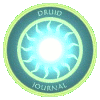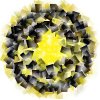This post is the second part of a series on the integration of several theories about the structure of consciousness. I’m going to charge right into the middle of it here, so make sure you’ve read the first part!

Western astrology is one of the oldest systems of thought still in use today. Its roots go back to ancient Egypt and Babylon. It is so old that the sky itself has changed more than it has. (A version of the system was certainly in use by 4000 B.C., when the vernal equinox was at Gemini, not Pisces.) Any system so old must resonate strongly with the human psyche, regardless of its efficacy as a predictor.
If the general conception of archetypes and circuits outlined in the previous post is correct, then astrology should be a map of the same territory. The core elements of astrology should match up with the core elements of the eight circuits, just as the archetypes did. Otherwise, one of the theories is deeply wrong or incomplete.
Astrology has four basic components: the 12 astrological signs (the zodiac), the planets (including the sun and moon), the 12 houses, and various aspects. In this essay I’m going to set aside the houses and the aspects. The houses are relatively late addition; I’ve heard it said that Johannes Kepler, for example, considered them an abomination. As for the aspects, they might best be considered from the standpoint of sacred geometry.
The Zodiac
The 12 signs of the zodiac are the stage upon which the houses, planets, and aspects make their play. (In fact, you could carry the metaphor further: the zodiac is the stage, the houses are the scenery, the planets are the actors, and the aspects, the script.) A planet’s character is affected by the sign it’s in. For example, the gregarious and friendly nature of Venus becomes sentimental in Pisces and demonstrative in Leo. But when the Sun is in a sign, the sign becomes a prototype for the core personality. For example, someone with Venus in Leo tends to be demonstrative around friends; someone with the Sun in Leo is always demonstrative.
Lining up the Stars and the Circuits
Astrology thus offers 12 basic personality types. Recall from the last post that the eight circuit model can generate four basic personality types by allowing for a combination of positive/negative imprinting in the first two circuits. How can astrology’s 12 be mapped to Leary and Wilson’s four?
As it turns out, the 12 signs of the zodiac can be divided evenly into four groups, with three signs in each group. The four groups correspond to the four classical elements: earth (Taurus, Virgo, Capricorn), air (Gemini, Libra, Aquarius), fire (Aries, Leo, Sagittarius), and water (Cancer, Scorpio, Pisces). Perhaps not coincidentally, the four personality types I mentioned in the last post are also associated with the four elements: earth is melancholic, air is sanguine, fire is choleric, and water is phlegmatic.
This is a welcome result. However, it is only meaningful if all of these lined-up symbols end up meaning the same thing. For example, is it in fact the case that the Gemini personality type is sanguine? Is a Leo choleric? Is a Taurus melancholic? And so forth. The answer here is yes, generally speaking. Gemini, for example, fits the sanguine personality type precisely. The other two air signs, Libra and Aquarius, may also be described as sanguine, although Libras tend to be rather more energetic, while Aquarians are rather more fixed in their beliefs.
But is this the whole story? If this is right, why are there 12 signs, instead of four? And how are the three signs in each element distinguished?
Four Times Three and Three Times Four
The answer is that, in addition to a ruling element, each sign has a quality. There are three qualities: cardinal, fixed, and mutable. There are four cardinal signs (Aries, Cancer, Libra, and Capricorn), four fixed signs (Taurus, Leo, Scorpio, and Aquarius) and four mutable signs (Gemini, Virgo, Sagittarius, and Pisces).
The three qualities of signs have different lenses by which they see the world. Cardinal signs are forward-looking; they are always thinking about the next thing, always getting ready for the next step. Fixed signs, on the other hand, tend to be conservative; they dislike change and are frequently focused on the past. Mutable signs are focused on the present: their moods and attitudes can change from moment to moment.
It is interesting to note that these three qualities correspond well with the three elements sacred to Revival Druidry: nwyfre (air), gwyar (water), and calas (earth). Earth (fixed) corresponds to physical, touchable objects; water (mutable) corresponds to events and processes; and air (cardinal) corresponds to thought and spirit.
Imprints of the Third Circuit
Does this threefold distinction correspond to anything in the eight circuit model? Actually, it does, in an intuitive way. Remember that the third circuit is the time-binding semantic circuit, the wetware program that manipulates metaphor, handles causality, and enables reason. Evidence from languages around the world shows that the human mind naturally divides events into three kinds: events that have passed, events that are ongoing, and events that have not happened (either because they are impossible, they are fantasy, they are in the future, etc.). Notably, other categories of events are possible (for example, English allows additional categories such as “habitual”), but these three are the essential ones found in every language.
Suppose that these three basic categories represent potential imprints of the third circuit? A third circuit imprint may be a preferred way of categorizing the world. If you are imprinted with a preference for completed processes, then you are focused on the past; you strongly prefer to categorize new experience based on old experience. And imprints based on the future (or fantasy) predisposes you to organize the world around plans, hopes, and dreams. A person whose third circuit is imprinted on present, ongoing processes, tends to live more in the moment, with less emphasis on the future or the past.
Doing this allows us to map the first three circuits directly onto the astrological signs. The signs become shorthand for a particular set of imprints on the first three circuits. Aries, cardinal fire, is first circuit negative, second circuit positive, and third circuit future. Taurus, fixed earth, is first circuit negative, second circuit negative, third circuit past. I have laid it all out in the following chart:
| SIGN | ELEMENT | QUALITY | 1ST CIRC | 2ND CIRC | 3RD CIRC |
|---|---|---|---|---|---|
| Aries | Fire | Cardinal | – | + | future |
| Taurus | Earth | Fixed | – | – | past |
| Gemini | Air | Mutable | + | + | present |
| Cancer | Water | Cardinal | + | – | future |
| Leo | Fire | Fixed | – | + | past |
| Virgo | Earth | Mutable | – | – | present |
| Libra | Air | Cardinal | + | + | future |
| Scorpio | Water | Fixed | + | – | past |
| Sagittarius | Fire | Mutable | – | + | present |
| Capricorn | Earth | Cardinal | – | – | future |
| Aquarius | Air | Fixed | + | + | past |
| Pisces | Water | Mutable | + | – | present |
Next Steps
The next logical question is how planets, aspects, and houses get into the system. This isn’t immediately obvious, but a couple of points might be made.
The seven planets plus the Earth might match up one-for-one with the eight circuits. Some of them map straightforwardly: Mercury goes with the third circuit, Mars with the second, Jupiter with the fourth. Slightly less obviously, Venus may mapped to the first. Beyond that, things are less clear. Alternatively, the planets may mapped to combinations of things: for example, the moon is commonly thought to rule emotion, but in the eight circuit model, emotions are distributed throughout the circuits. So it may be that each planet is represented in all the circuits. More study is needed here.
If you use astrology for meditation or divination, consider referring to the correspondence chart I provided as a source of inspiration and insight. For example, if your moon is in Pisces like mine, you may find yourself beset by strong sentimentality and emotions that pass by like shifting cloud shapes. Remember that your positive first circuit is ruled by Freyr, god of fertility; a mixture of rain and sun creates the most fertile ground for a rich, nourishing emotional life. Remember that your negative second circuit is ruled by Thor, whose unwavering loyalty to his father Odin gives his matchless power meaning and purpose. And remember, too, that although your present-time imprint on the third circuit may give you an uncertain memory and make it hard to become emotionally involved with practical planning, you find it easy to focus on the present, which is the only true reality.






Leave a comment